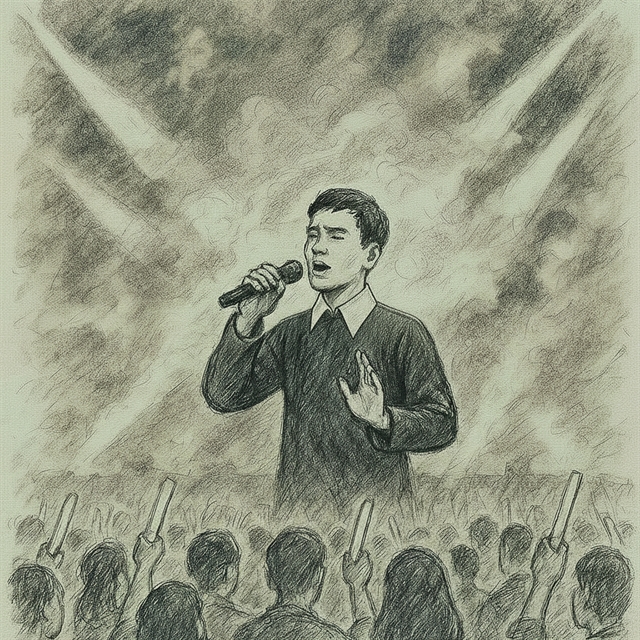Weather:
- Ha Noi 25oC
- Da Nang 25oC
- Ho Chi Minh 26oC

By An Phương
As vulgar lyrics and suggestive imagery increasingly contaminate Việt Nam’s online music scene, authorities and audiences alike are beginning to question where to draw the line between creative freedom and cultural responsibility.
In recent months, several songs by young artists such as J., B.G., and A., among others, have sparked controversy for their use of vulgar and inappropriate language.
In response, authorities last month issued an official directive, calling for guidance and correction of music activities showing signs of cultural deviation. The move is widely seen as a sign that the era of “views by vulgarity” may be coming to an end.
“This type of music, mostly found in the rap genre, has been around for years. In fact, I’ve started to see the kind of lyrics used in these songs as somewhat ‘normal’. I don’t think much about them anymore, even though I still find them offensive at times. The government’s recent move is refreshing, as it makes me rethink how I should view this issue,” my friend Ngọc Lan, 27, told Việt Nam News.
Another friend of mine, Thanh Tâm, 30, is a huge fan of some of the artists mentioned.
“As much as I’d love to support local artists, I think it’s important to draw a clear line between entertainment and what isn’t, especially when teenagers and young adults are the ones consuming this kind of content,” she said.
In the age of social media, a short “viral” clip on TikTok can reach millions of viewers, many of them young audiences. This has allowed numerous songs with offensive or suggestive lyrics to spread widely online despite their controversial content.
“I have every reason to believe that such controversial releases are part of a deliberate strategy. Using offensive words is a risk these artists knowingly take to gain attention and make their songs go viral,” Lan said.
I completely agree with Lan. Some artists seem to rely on shock tactics to attract attention, following the logic that “the more offensive it is, the more viral it becomes, and the more viral it gets, the more reason there is to keep doing it."
Others may argue that music is a form of art, and art should be all about creative freedom. After all, it is common for international artists, especially those from Western cultures, to express themselves fully, even through shocking or provocative lyrics.
However, as vulgar language and inappropriate imagery become increasingly common in today’s music, it is important to remember that “creative freedom” should not be used as an excuse to justify what is offensive.
“We are living in an Asian country that values the saying ‘tiên học lễ, hậu học văn’ (manners before knowledge). We can integrate with the world, but we should not lose our cultural identity. What is right should be encouraged, and what is not should be limited,” Tâm said.
“When obscene language and inappropriate imagery are brought onto the stage and social media under the name of ‘creative freedom,’ the problem is no longer just about taste. It becomes a question of where to draw the line between artistic expression and cultural responsibility,” Lan added.
In my opinion, art holds its true meaning only when it strives for beauty, respects culture, and honours its audience.
Rap music was originally born as a form of self-expression in communities that faced social oppression. Yet, we need to recognise that today’s society is very different from what it used to be. Our world has become more civilised, and so should the way we express ourselves through art.
Stronger measures needed
Recent discussions on the issue suggest that to tackle its root causes, society must take a comprehensive approach, from the awareness of songwriters to the role of state management and even the audience’s attitude in receiving such works.
According to music researcher Nguyễn Quang Long, creative freedom is a right, but it must come with responsibility.
“Every artist and producer should be aware that if their work is culturally inappropriate, vulgar, or lacks artistic integrity, they must take full responsibility before both the public and the law,” he said.
In the long run, Long added, the focus should be on “ethical and cultural education for young artists,” along with learning from countries like South Korea and China, where both the government and the community work together to help artists understand the limits of creativity.
“Creativity should never be restricted, but it must be grounded in knowledge, professional ethics, and an awareness of social impact. In the end, art should aim for beauty, not be used to justify what is ugly,” Long said.
Associate Professor Dr. Bùi Hoài Sơn also emphasised the role of audiences in keeping the music industry healthy.
“A strong cultural environment cannot rely solely on bans; it also requires self-awareness from the listeners. When audiences learn to reject what is harmful and stop sharing inappropriate content, the market will naturally adjust itself,” Sơn said.
He believes that in art, “the silence of the public in the face of vulgarity can sometimes be the strongest form of protest.”
Lan, Tâm and I also believe that, in addition to penalising artists, a more important task is regulating the platforms that distribute their content.
“Digital platforms such as YouTube, TikTok or Spotify must be subject to stricter regulations that compel them to comply with local laws,” we agreed.
As the line between art and shock value continues to blur, Việt Nam’s music scene stands at a crossroads.
Finding the balance between creativity and responsibility will require not just stronger regulations or ethical education for artists, but also a more discerning audience.
After all, the true strength of art lies not in how loudly it provokes, but in how deeply it connects, with respect, culture, and conscience. - VNS
